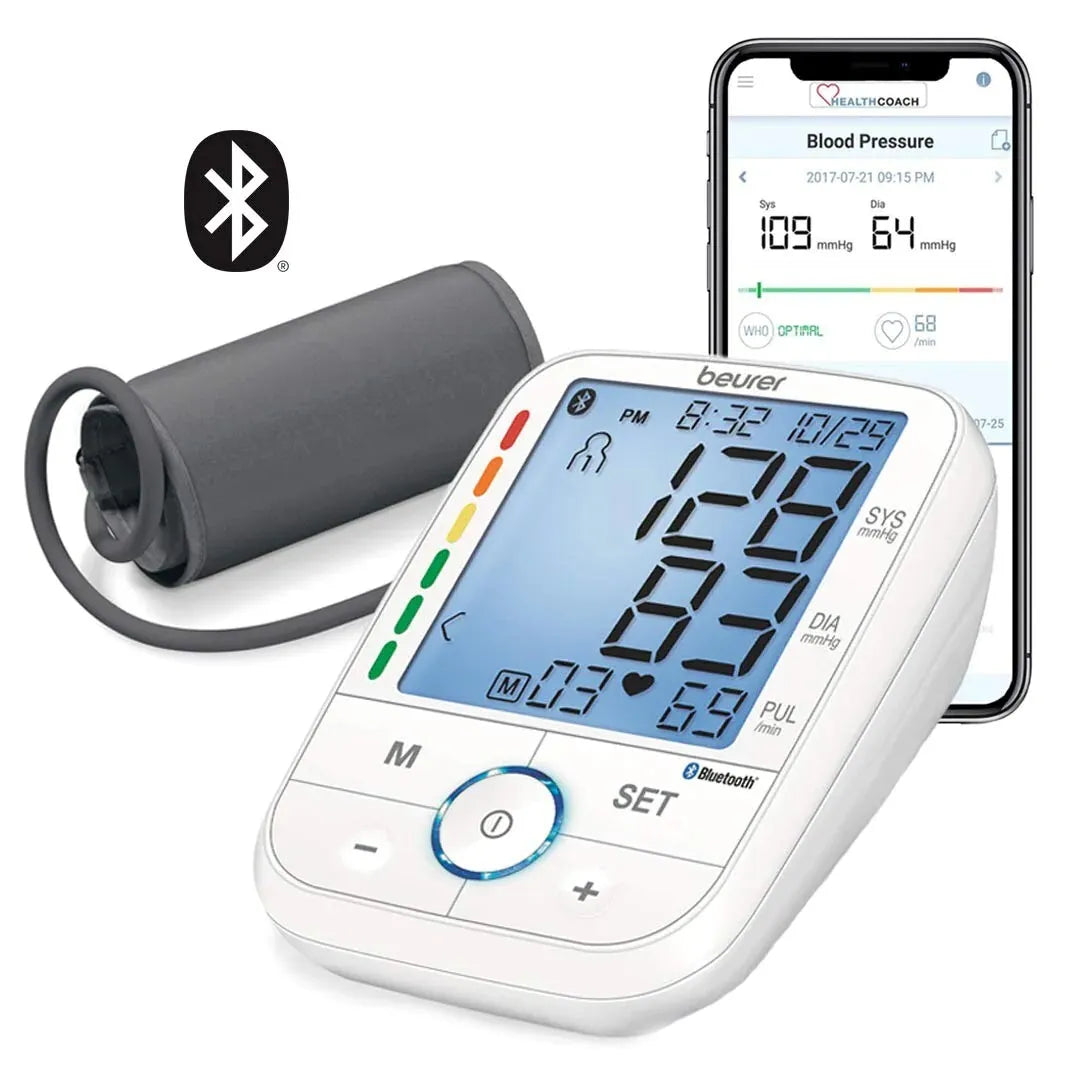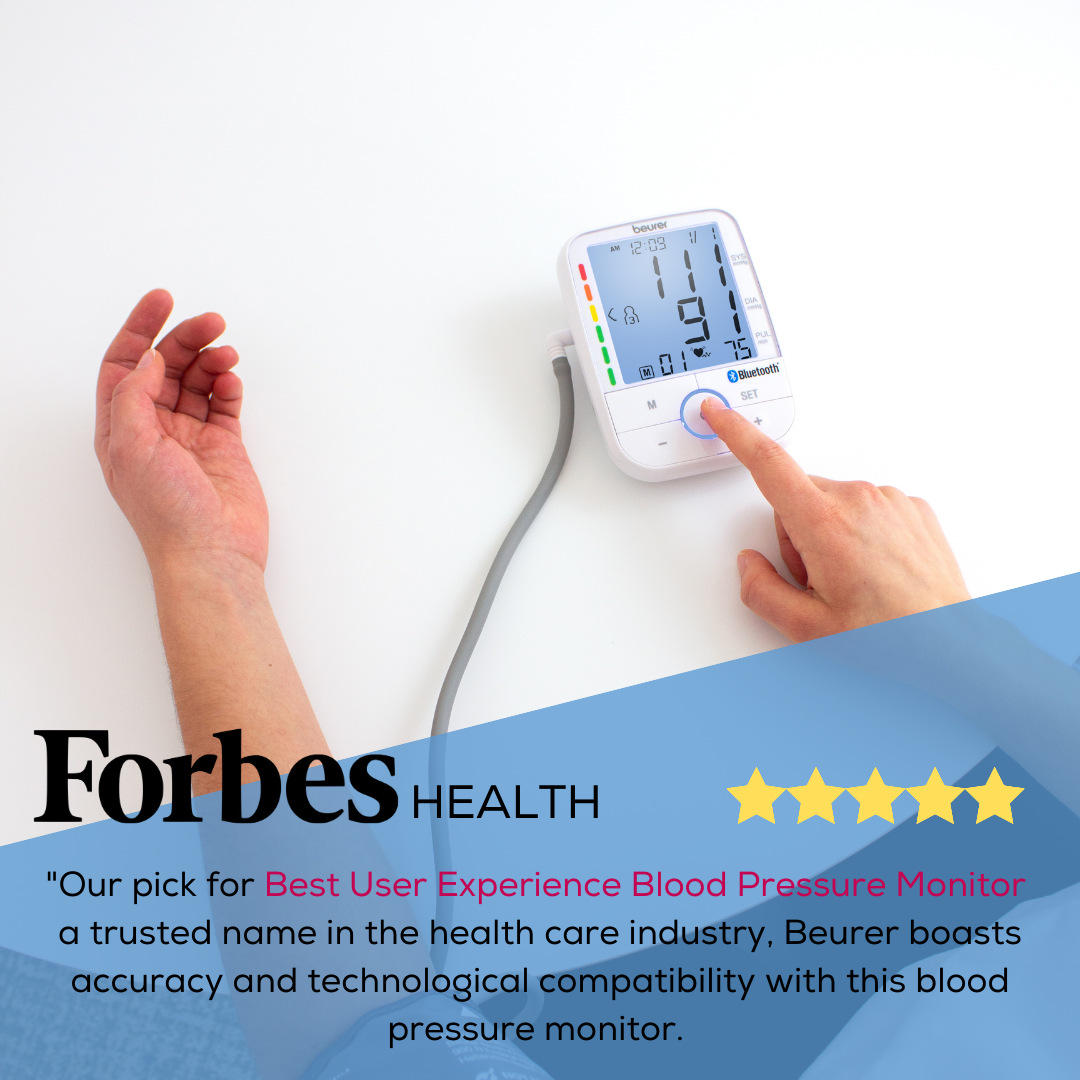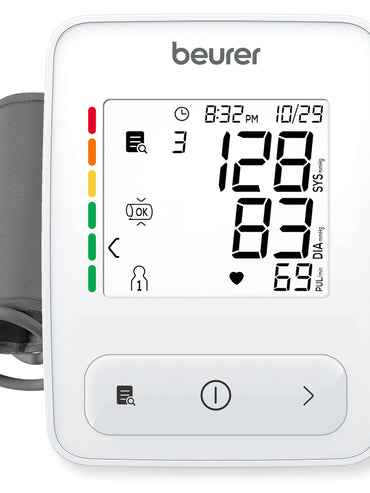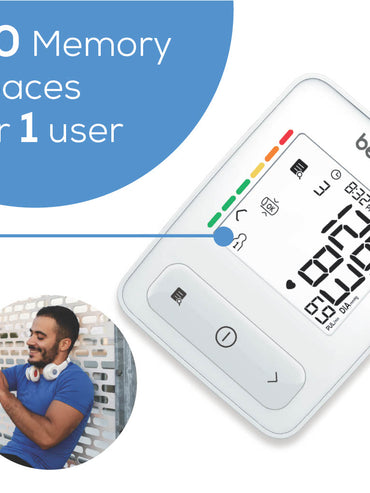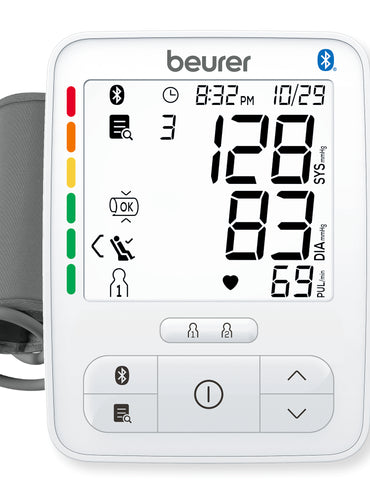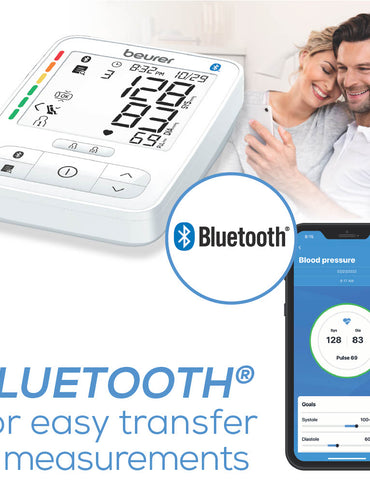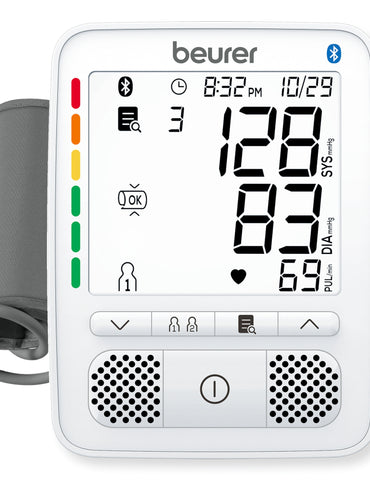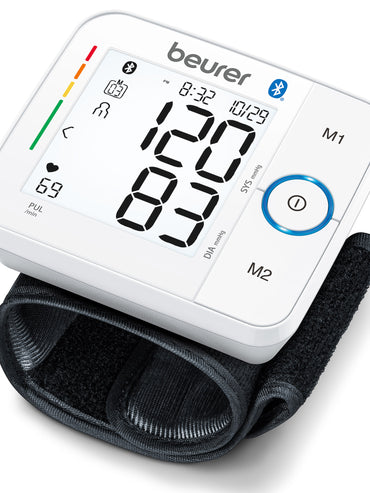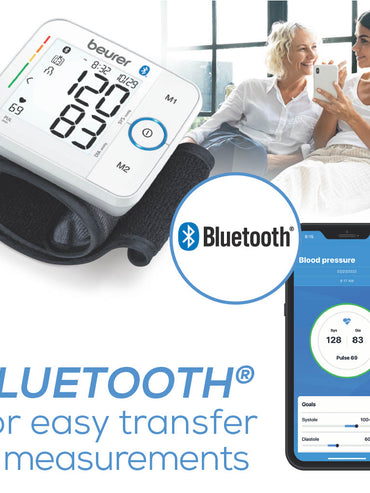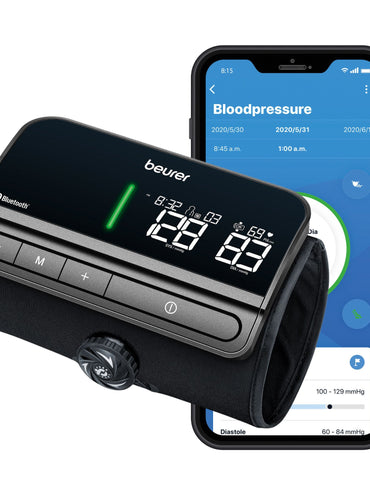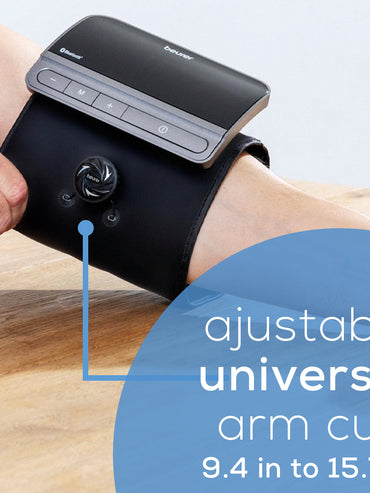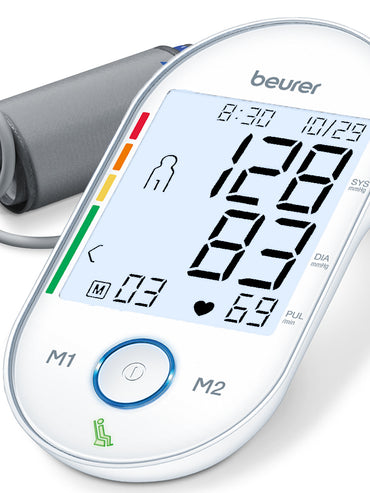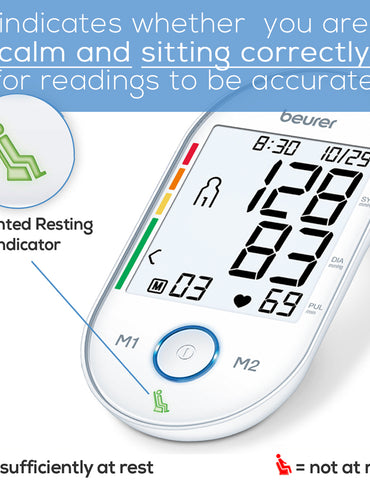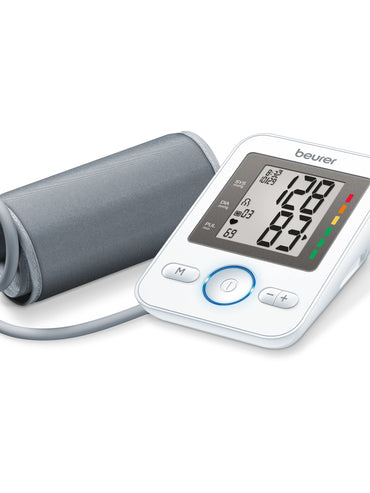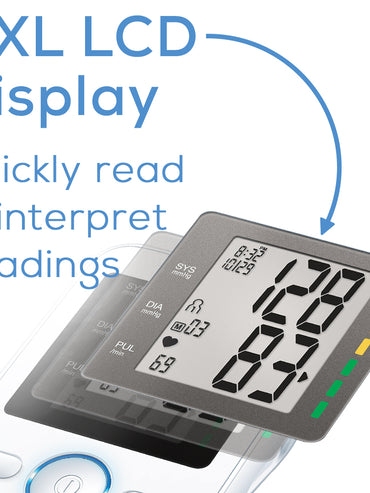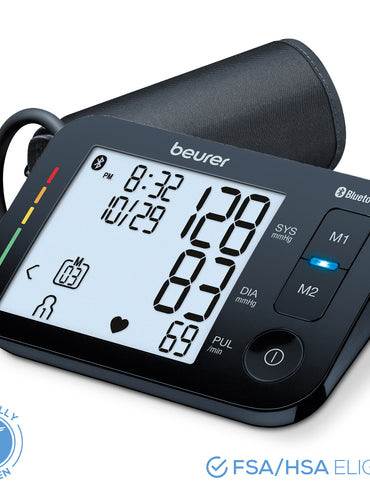Bluetooth Upper Arm Blood Pressure Monitor, BM76
Bluetooth Upper Arm Blood Pressure Monitor, BM76,
In Stock: 13 available
- LET US HELP: Our automatic monitor with pulse detection is seamless & comfortable. The set includes batteries, a storage case, and a cuff that fits upper arm circumferences from 8.7 to 17.3 inches
- SMART BPM: The device easily synchronizes with your smartphone via Bluetooth so you track your blood pressure and see how your readings look over time - as well as show your doctor
- HEART RHYTHM DISTURBANCES: This unit automatically identifies and alerts you to any heart rhythm disturbances. If detected, a warning symbol will be displayed after the measurement is taken
- EASY INTERPRETATION: Our unit makes interpretation of your results easier than ever with a colored risk indicator, which tells you where your blood pressure lies on the scale - based on the WHO metrics
- EASY TO USE: The XL blue illuminated LCD display makes the BM67 easy to read, reading glasses are not needed! With one button, the BM67 measures systolic & diastolic blood pressure & pulse measurement
- MULTIPLE USERS: 4 users can store up to 30 records/measurements each (+unlimited via app), so you can use one monitor for the family! The unit also features an automatic switch-off for convenience
- WE'RE HERE FOR YOU: Our friendly Florida-based team is happy to assist you with whatever questions and support you may need. That's right, our customer service is located right here in the USA!
- Product Dimensions: 5.5 x 4 x 2.1 inches; 1.4 Pounds
Download this product's instruction manual here
✖
How do you know if you have high blood pressure?
High blood pressure, also known as hypertension, is typically defined as a systolic blood pressure (the top number) of 140 mmHg or higher, or a diastolic blood pressure (the bottom number) of 90 mmHg or higher. Some signs of hypertension can include headaches, fatigue, nosebleeds, and difficulty breathing, but these symptoms are not always present and are not specific to hypertension. It is important to have your blood pressure checked regularly, and talk to your doctor if you have any concerns.

What Can Cause High Blood Pressure?
Age
High blood pressure is more common as people age. The risk of developing itgoes up with age, prevalent in older adults.
Physical Inactivity
Lack of regular physical activity can lead to weight gain, obesity, and an unhealthy lifestyle, all of which can contribute to the development of high blood pressure.

Tobacco & Alcohol
Smoking cigarettes or using other tobacco products can damage blood vessels and increase the risk of having high blood pressure.
Pregnancy
Gestational hypertension, is a common condition that affects many pregnant women. It is defined as blood pressure of 140/90 mmHg or higher after 20 weeks of pregnancy.

Age
High blood pressure is more common as people age. The risk of developing itgoes up with age, prevalent in older adults.
Physical Inactivity
Lack of regular physical activity can lead to weight gain, obesity, and an unhealthy lifestyle, all of which can contribute to the development of high blood pressure.
Tobacco & Alcohol
Smoking cigarettes or using other tobacco products can damage blood vessels and increase the risk of having high blood pressure.
Pregnancy
Gestational hypertension, is a common condition that affects many pregnant women. It is defined as blood pressure of 140/90 mmHg or higher after 20 weeks of pregnancy.
Frequently Asked Questions
How do I properly measure my blood pressure?
1. Rest for at least 5 minutes before taking your blood pressure. Avoid smoking, drinking caffeine, or exercising for at least 30 minutes before taking your blood pressure.
2. Sit in an upright position with your back supported and your feet flat on the floor.
3. Place the blood pressure cuff on your bare skin, with the cuff's lower end, about 1 inch above the bend of your elbow.
4. The cuff should be snug but not tight. Make sure that the bottom of the cuff is level with the center of your heart.
5. Press the "start" button on the blood pressure monitor.
6. Do not talk or move during the measurement.
Why do I get different readings at home than at the doctor's office?
There are numerous factors that can lead to differences in blood pressure measurements between those taken at the doctor's office and elsewhere. The following are among the most common reasons, though this list is not exhaustive.
1. White Coat Effect: Anxiety or stress induced by the medical environment can lead to higher blood pressure readings, known as the white coat effect.
2. Technique Discrepancies: Inaccuracies in the measurement technique, such as improper cuff size or positioning, can cause variations in readings between different healthcare providers or settings.
3. Time of Measurement: Blood pressure can fluctuate throughout the day due to various factors like activity level, stress, or recent food or caffeine intake, leading to different readings.
Is an upper arm monitor more accurate than wrist?
Both types of monitors can be accurate, but there are some differences to consider when choosing between them.
Upper Arm: considered to be the most accurate type of home blood pressure monitors. These monitors are generally larger and more complex than wrist monitors, but they are more accurate and reliable.
Wrist: These kinds of monitors are equally acuurate, however, the position of the wrist during measurement can also affect the accuracy of the reading. The American Heart Association recommends that wrist monitors should be positioned at the same level as the heart, which can be difficult to achieve when using a wrist monitor.
What is the best time to measure my blood pressure?
The best time to measure your blood pressure can vary depending on your routine and any specific instructions from your healthcare provider. However, there are a few general recommendations:
1. Consistency: Try to measure it at the same time each day for consistency in readings.
2. Morning and Evening: Some people measure their blood pressure in the morning before taking medications or eating and in the evening before bedtime.
3. Before Medication: If you're taking medications for blood pressure or other conditions, check with your doctor about the best time to measure it in relation to your medication schedule.















